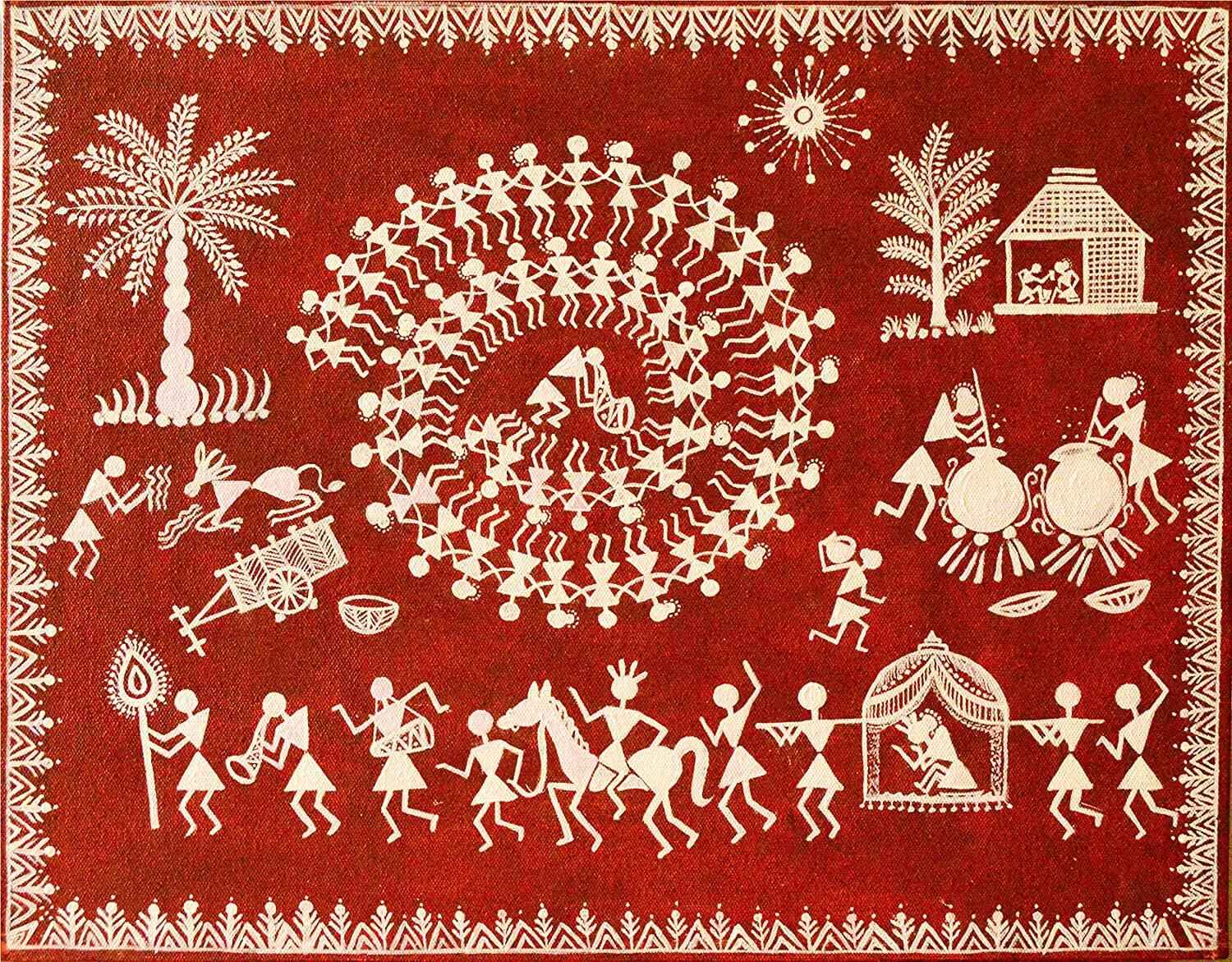Table of Contents
Warli painting, an ancient art form originating from the tribal communities of Maharashtra, India, is a testament to the rich cultural heritage and artistic prowess of these indigenous people. Dating back to as early as 3000 BCE, Warli painting is a unique expression of the daily lives, rituals, and beliefs of the Warli tribe. This traditional art form has not only survived the test of time but has also gained recognition and admiration on a global scale for its simplicity, symbolism, and cultural significance.
Warli Painting or Warli Art
- It is a traditional tribal art form. It originated with the Warli tribe which resides in North Sahyadri Range of Maharashtra.
- It uses basic geometric shapes—circles, triangles and squares to depict everyday village life, rituals, and nature, with scenes of hunting, fishing, farming, festivals and dances.
- Traditionally, the art was created on the walls of mud huts using natural pigments like rice paste (for white) and mud-brown from the earth.
- Bamboo sticks were used as paintbrushes, and the paintings were often created by women of the Warli tribe.

Historical Background of Warli Painting
The roots of Warli painting can be traced to the Warli tribe, an Adivasi community inhabiting the mountainous and coastal areas of Maharashtra, particularly in the Thane district. The word “Warli” is derived from the word “warla,” which means piece of land. These paintings were initially created by the women of the tribe on the walls of their homes using a mixture of rice paste and water, often depicting scenes from daily life, agricultural practices, and religious ceremonies.
Characteristics of Warli Painting
Warli painting, a vibrant art form originating from Maharashtra, India, boasts unique characteristics that have captivated audiences for centuries. Here are some of its distinctive characteristics:
Origin and Inspiration
Warli paintings, originating in the tribal communities of Maharashtra, India, are a fascinating reflection of the daily life and cultural ethos of the Warli tribe. These art forms find their roots in the experiences and rituals of the tribe, showcasing a unique blend of simplicity, symbolism, and cultural heritage.
Subject Matter
The majority of Warli art revolves around the depiction of daily occurrences and rituals experienced by the Warli tribe. Notably, the paintings often feature humans dancing in spirals and open-ended circles, capturing the essence of tribal life and community celebrations.
Medium of Expression
Originally confined to the walls of tribal homes, Warli art has transcended its traditional canvas. Artists now employ various mediums, including bamboo, cloth, mud pots, and dried bottle gourds, expanding the scope and versatility of this ancient art form.
Evolution of Colors
In its early stages, Warli paintings utilized a limited colour palette, featuring earth brown and rice paste. However, as the art form evolved, so did its spectrum of colours. Today, Warli’s art incorporates hues such as Henna, Indigo, Ochre, Black, Earthy mud, and Brick red, adding vibrancy and depth to the visual narratives.
Gender Dynamics in Artistic Expression
Originally exclusive to Warli women known as Savasini, the practice of painting Warli art has evolved to include men over time. This shift reflects a broader acceptance of artistic expression within the community and the evolving roles of men in preserving their cultural heritage.
Absence of Legendary Narratives
Unlike some art forms that depict legendary stories, Warli paintings are rooted in the here and now. They do not narrate myths or legends but rather capture the daily lives, rituals, and beliefs of the Warli tribe, making the art form deeply personal and reflective of the community’s lived experiences.
Iconic Paintings
One of the most renowned Warli paintings is the ‘Chawk,’ featuring married women adorning their kitchen walls with white paint. Another notable artwork centres around the Goddess Palaghat, a fertility deity, surrounded by depictions of trees, daily chores, dancers, women’s tools, and animals, creating a visually rich narrative.
Geometric Shapes in Warli Art
The basic geometric shapes employed in Warli wall paintings include triangles, circles, squares, dots, and dashes. These simple yet powerful shapes contribute to the distinctive visual language of Warli art, emphasizing symbolism and the interconnectedness of the tribal community with nature.
Categories of Warli Paintings
Warli paintings can be categorized into four distinct genres:
- The Gods: Inspired by historical folklore, these paintings express the tribe’s belief in their cultural and spiritual history.
- The People: Reflecting both the virtuous and questionable deeds of individuals within the community.
- The Creatures: Depicting various animals indigenous to the region, with the tiger being a recurring motif in Warli art.
- Rights and Rituals: The most prominent category, illustrating joy, happiness, celebrations, and day-to-day activities, offering a glimpse into the cultural practices of the Warli tribe.
Warli Painting UPSC
Warli painting, originating from Maharashtra’s tribal communities, serves as a cultural testament dating back to 3000 BCE. Reflecting the Warli tribe’s daily life and beliefs, this ancient art form has gained global recognition for its simplicity and cultural significance. Initially created on home walls by Warli women, it depicts rituals, agricultural practices, and daily life. The art has evolved, employing mediums like bamboo and cloth, with an expanded color palette.
While traditionally exclusive to women, men now partake, broadening artistic expression. Warli paintings lack legendary narratives, focusing on four categories: Gods, People, Creatures, and Rights and Rituals. Iconic works like ‘Chawk’ and depictions of Goddess Palaghat showcase the art’s richness, utilizing basic geometric shapes to emphasize tribal interconnectedness with nature.


 Jallianwala Bagh Massacre, Date, History...
Jallianwala Bagh Massacre, Date, History...
 Chittorgarh Fort: Mining Ban within 10 k...
Chittorgarh Fort: Mining Ban within 10 k...
 PM Modi visits Wat Pho Temple in Bangkok
PM Modi visits Wat Pho Temple in Bangkok





















